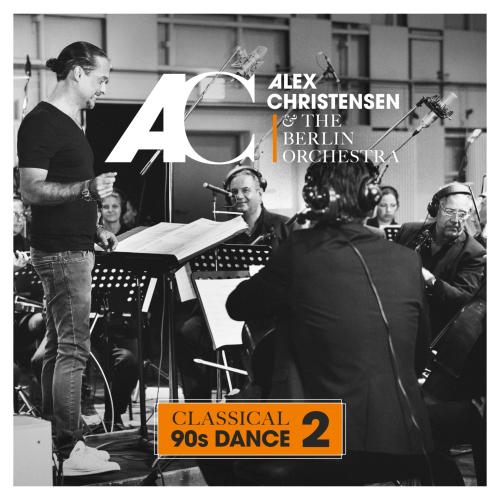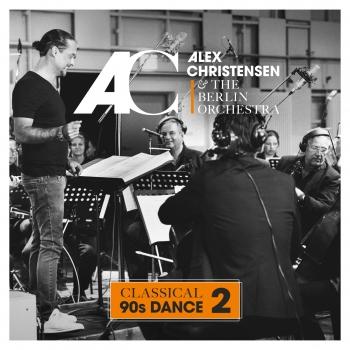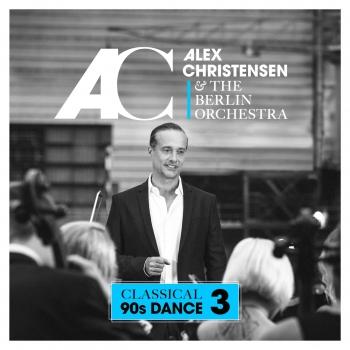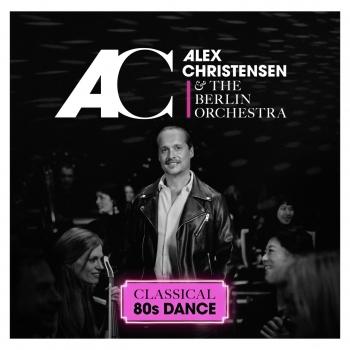
Classical 90s Dance 2 Alex Christensen & The Berlin Orchestra
Album Info
Album Veröffentlichung:
2018
HRA-Veröffentlichung:
19.10.2018
Label: Starwatch Distribution/WM Germany
Genre: Electronic
Subgenre: Electronica
Interpret: Alex Christensen & The Berlin Orchestra
Das Album enthält Albumcover
Entschuldigen Sie bitte!
Sehr geehrter HIGHRESAUDIO Besucher,
leider kann das Album zurzeit aufgrund von Länder- und Lizenzbeschränkungen nicht gekauft werden oder uns liegt der offizielle Veröffentlichungstermin für Ihr Land noch nicht vor. Wir aktualisieren unsere Veröffentlichungstermine ein- bis zweimal die Woche. Bitte schauen Sie ab und zu mal wieder rein.
Wir empfehlen Ihnen das Album auf Ihre Merkliste zu setzen.
Wir bedanken uns für Ihr Verständnis und Ihre Geduld.
Ihr, HIGHRESAUDIO
- 1 Blue (feat. Bars and Melody) 03:58
- 2 Around the World (feat. Melanie C) 03:29
- 3 Another Night (feat. Anastacia) 03:21
- 4 Because I Love You (feat. Pietro Lombardi) 04:07
- 5 Mr. Vain (feat. Anastacia & SKI) 04:21
- 6 Feels Like in Heaven (feat. Yass) 04:06
- 7 Don't Talk Just Kiss (feat. Melanie C) 04:02
- 8 Sandstorm 04:46
- 9 Everybody's Free (feat. Linda Teodosiu) 04:23
- 10 Freed from Desire (feat. Beymarie) 04:08
- 11 Insomnia (feat. SKI) 03:45
- 12 Listen to Your Heart (feat. Medina) 03:30
- 13 Something (feat. Asja Ahatovic) 03:47
- 14 Adagio for Strings 03:49
Info zu Classical 90s Dance 2
Als Alex Christensen im Oktober 2017 sein ambitioniertes Projekt Classical 90s Dance veröffentlichte, war ihm die Neugierde von Kollegen, Fans und Medien gewiss. Als wichtigster deutscher Impulsgeber der Techno-, Dance- und Eurodance-Bewegung, erarbeitete er sich zunächst als DJ und Komponist, schnell aber auch als Producer Weltruhm. Plötzlich sollte der Mann, der seit Anfang der 90er-Jahre vorzugsweise im Hintergrund die musikalischen Strippen für über 40 Millionen verkaufter Tonträger zog, erklären, was es mit Classical 90s Dance auf sich hatte.
Dass einer wie er eine persönliche Auswahl charakteristischer Hits des Genres neu arrangierte und mit dem 49-köpfigen Berlin Orchestra aufnahm, schuf Aufmerksamkeit. Und ganz nebenbei war so ein eigenes neues Genre geboren: Orchestral Dance Music ! Der Erfolg gab ihm recht: Top-10-Charts Platzierungen, über 25 Wochen in den Charts, mittlerweile über 60.000 verkaufte Exemplare & 10 Millionen Video-Views weltweit katapultierten den eher zurückhaltenden Charakter direkt dahin, wo er eigentlich nie hinwollte: ins Rampenlicht. Ich war überrascht darüber, dass das Album so schnell und gut angenommen wurde", erinnert sich Alex Christensen. Das Konzept und dessen Umsetzung hatte schließlich vorher niemand getestet. Der Erfolg gab meiner Idee, Hits der tanzbaren, elektronischen Musik der 90's mit Elementen der Klassik zu verbinden, eine zusätzliche Berechtigung. Und er ließ den Wunsch wachsen, das Projekt fortzusetzen.
Classical 90s Dance 2 ist nun die konsequente Fortsetzung und der vorläufige Höhepunkt seiner bald vier Jahrzehnte andauernden Musikreise. Immer am Puls der Zeit, immer mit dem einzigartigen Riecher für Hits, setzt er sein Unterwegssein als Musikverrückter demnächst mit der Live-Umsetzung des Konzepts fort. Es geht ihm immer darum, musikalisches Neuland zu entdecken. Als Produzent, Arrangeur und auch als Fan. Vielleicht ist Classical 90s Dance auch deswegen ein erfolgreiches Ausnahmeprojekt geworden. Alex Christensen ist ein Musik-Fan geblieben.
Alex Christensen
Music is like history. When the system goes through a change, the counterrevolution is usually not far behind. In the 1980s only high-earners could shape the future of music. Sampling was the word of the day and anyone who could spend half a million dollars could sample right along – using sluggish equipment that was already completely outdated. Young people, always the most important driving force behind pop music, couldn’t boast a Trevor Horn because they couldn’t operate the means of production.
At the change of decades revolution was in the air in the clubs when DJs changed the music to a persistent rapid beat. The tools were simple: catchy ideas, two turntables, samplers that were now affordable, a microphone, and haunting or original voices. Again, the hits came from the underground, from sweat-drenched fanatics mixing house beats with their own short, concise melodies. Techno dance, the youth and party culture whose offshoots persist to this day, permanently reoriented music perception.
Alex Christensen, a DJ of the first hour (long before there were USB sticks, by the way), set the tone when he helped get the techno dance and Euro-dance movement going. He first got Germany dancing, then Europe, and finally the whole world. Almost on his own. He penned Ritmo de la noche, the summer hit from 1990. Things then started happening in rapid succession for the self-described music maniac from Hamburg: the first gold record for Ritmo, constant inquiries for production jobs, every club wanted to book him as DJ to guarantee a full house.
Finally in 1991 he fired off a rocket of unimagined magnitude: Das Boot by U96 stayed at number one on the German singles charts for a full 13 weeks, caused an uproar throughout Europe, and single-handedly paved the way for the techno scene to enter the mainstream. Alex Christensen was everywhere: the cover of BRAVO, guest roles in Hollywood films and on the series Marienhof – the whole nine yards. What no one dreamed at the time is now a fact. The name Alex Christensen has become one of the few abiding brands of the international music scene.
His list of credits is as long as it is impressive. He’s worked with Udo Lindenberg, Helene Fischer, Söhne Mannheims, Tom Jones, Paul Anka, Sarah Brightman, Mark Wahlberg aka Marky Mark. He’s been a judge on Popstars, has had great success with his own songs time after time (Du hast den schönsten Arsch der Welt), and through it all has always been someone who prefers to remain backstage. Talk to him today and he’ll call himself a “music-obsessed family man who can’t leave well enough alone and is constantly challenging himself to explore new musical adventures.”
He goes on to say that music brings out a downright childlike play instinct in him. Even now. After unknown thousands of hours in the studio, DJ booth, using analog equipment that would easily fill a truck. We can take his word for it. His range – the spectrum of musical styles that have given inspiration to his pop music for the past three decades – is unprecedented. Dance tracks, ballads, electronic excursions, classic singer-songwriter projects, flawless pop: under Alex Christensen’s production everything sounds like it should sound, but never by accident. Alex Christensen’s most extraordinary project to date is now finally approaching completion.
With Classical 90s Dance this reserved German has come full circle, as he puts it. “‘Das Boot’ was originally a piece for strings. But when we recorded it with U96 in 1991, I had neither the knowledge nor the tools to record with strings. The fact that I’ve now been able to combine orchestral music with my dance roots while recording Classical 90s Dance rounds out my entire oeuvre. People can finally understand why Christensen spent ten years on orchestral music.” Alex Christensen created the 49-member Berlin Orchestra, a gathering of the capital’s best orchestral musicians, specifically for this album. And he hired very young female vocalists exclusively, with the plan to revitalize a selection of the best techno dance tracks of the 90s with a modern sensibility.
Who could have been more predestined for this task than Alex Christensen? Under his direction Classical 90s Dance has become an extraordinary project, large and ambitious – much more than a remake or remix of early-90s hits. Together Christensen and the Berlin Orchestra rock the patina and mildew from the graceful contours of the 14 songs. “Once the pieces were freed from their admittedly antiquated-sounding gowns, I felt there were first-rate songs with wonderful structures hiding behind the dance costumes, if you will,” Christensen rhapsodizes. “They have entered the DNA of people my age or 15 to 20 years younger. I’m sure a lot of people will revel in these songs again when they hear our modern versions. They sound like they’ve continued their logical development.”
Rhythm Is A Dancer, Sonic Empire, Nessaja in the Scooter version, What Is Love, Redemption, and Children can be discovered and enjoyed differently in the new Classical 90s Dance versions: still danceable but no longer arranged primarily for dancing – not by a long shot. The Rise / No Limit even plays around with sumptuous Wagner references and so really has no limits any longer. “When I was selecting the songs for the album, of course I had a mountain of material to work with,” recalls Alex Christensen. “However, quite a few things didn’t make it to the final decision because they simply didn’t move me. But all the songs that made it into the album have great emotional value. Classical 90s Dance could have a subtitle if it weren’t so long: The evolution of dance tracks into songs whose emotional content is unconditionally moving.”
Dieses Album enthält kein Booklet












